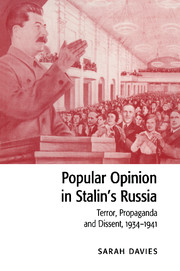Book contents
- Frontmatter
- Contents
- List of tables
- Acknowledgements
- Chronology
- List of abbreviations and archive references
- Glossary and notes on the text
- Introduction
- PART I ECONOMY AND SOCIETY
- PART II POLITICS AND TERROR
- PART III THE LEADER CULT
- 9 The leader cult in official discourse
- 10 Affirmative representations of the leader and leader cult
- 11 Negative representations of the leader and leader cult
- Conclusion
- Notes
- Bibliography
- Index
10 - Affirmative representations of the leader and leader cult
Published online by Cambridge University Press: 25 March 2010
- Frontmatter
- Contents
- List of tables
- Acknowledgements
- Chronology
- List of abbreviations and archive references
- Glossary and notes on the text
- Introduction
- PART I ECONOMY AND SOCIETY
- PART II POLITICS AND TERROR
- PART III THE LEADER CULT
- 9 The leader cult in official discourse
- 10 Affirmative representations of the leader and leader cult
- 11 Negative representations of the leader and leader cult
- Conclusion
- Notes
- Bibliography
- Index
Summary
The official cult discourse fluctuated and transmitted heterogeneous messages. Not surprisingly, then, when the people themselves used this discourse, they chose to emphasise different facets in accordance with their own situation, needs, and ideas about leadership. The following analysis is based predominantly on positive representations of the leader in letters. The latter are used because they are usually more individual and less imitative of the propaganda than the comments reproduced in opinion reports and newspapers. Three different types of discourse can be identified: firstly, the leader as benefactor; secondly, the leader as ‘traditional’ defender of the people; and, finally, the charismatic leader. In many cases these different discourses overlapped, but they will be examined here separately.
THE LEADER AS BENEFACTOR
This type of representation was rarely employed by the social groups with whom this study is mainly concerned. It was mainly used by those who improved themselves in this period, and identified with the regime and its policies. These beneficiaries included many Stakhanovites, some soldiers, the new young intelligentsia, and the vydvizhentsy (upwardly mobile), who moved into responsible positions in the hierarchy. Often from humble origins, they had acquired power and status, and were eager to express gratitude to Stalin, and endorsed the progress the USSR had made under his leadership. They were also well versed in the official language. Soldiers in particular had a good command of the phraseology, thanks to intensive indoctrination in the Red Army.
- Type
- Chapter
- Information
- Popular Opinion in Stalin's RussiaTerror, Propaganda and Dissent, 1934–1941, pp. 155 - 167Publisher: Cambridge University PressPrint publication year: 1997



